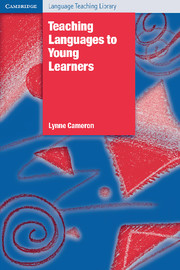Book contents
- Frontmatter
- Contents
- Preface
- Acknowledgements
- 1 Children learning a foreign language
- 2 Learning language through tasks and activities
- 3 Learning the spoken language
- 4 Learning words
- 5 Learning grammar
- 6 Learning literacy skills
- 7 Learning through stories
- 8 Theme-based teaching and learning
- 9 Language choice and language learning
- 10 Assessment and language learning
- 11 Issues around teaching children a foreign language
- References
- Index
1 - Children learning a foreign language
Published online by Cambridge University Press: 05 May 2010
- Frontmatter
- Contents
- Preface
- Acknowledgements
- 1 Children learning a foreign language
- 2 Learning language through tasks and activities
- 3 Learning the spoken language
- 4 Learning words
- 5 Learning grammar
- 6 Learning literacy skills
- 7 Learning through stories
- 8 Theme-based teaching and learning
- 9 Language choice and language learning
- 10 Assessment and language learning
- 11 Issues around teaching children a foreign language
- References
- Index
Summary
Taking a learning-centred perspective
What is different about teaching a foreign language to children, in contrast to teaching adults or adolescents? Some differences are immediately obvious: children are often more enthusiastic and lively as learners. They want to please the teacher rather than their peer group. They will have a go at an activity even when they don't quite understand why or how. However, they also lose interest more quickly and are less able to keep themselves motivated on tasks they find difficult. Children do not find it as easy to use language to talk about language; in other words, they do not have the same access as older learners to metalanguage that teachers can use to explain about grammar or discourse. Children often seem less embarrassed than adults at talking in a new language, and their lack of inhibition seems to help them get a more native-like accent. But these are generalisations which hide the detail of different children, and of the skills involved in teaching them. We need to unpack the generalisations to find out what lies underneath as characteristic of children as language learners. We will find that important differences do arise from the linguistic, psychological and social development of the learners, and that, as a result, we need to adjust the way we think about the language we teach and the classroom activities we use. Although conventional language teaching terms like ‘grammar’ and ‘listening’ are used in connection with the young learner classroom, understanding of what these mean to the children who are learning them may need to differ from how they are understood in mainstream language teaching.
Information
- Type
- Chapter
- Information
- Teaching Languages to Young Learners , pp. 1 - 20Publisher: Cambridge University PressPrint publication year: 2001
Accessibility standard: Unknown
Why this information is here
This section outlines the accessibility features of this content - including support for screen readers, full keyboard navigation and high-contrast display options. This may not be relevant for you.Accessibility Information
- 2
- Cited by
